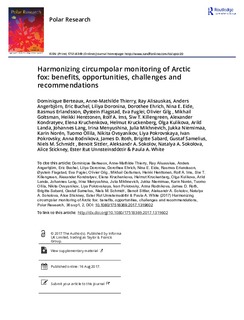Harmonizing circumpolar monitoring of Arctic fox: benefits, opportunities, challenges and recommendations
Berteaux, Dominique; Thierry, Anne-Mathilde; Alisauskas, Ray; Angerbjörn, Anders; Buchel, Eric; Doronina, Liliya; Ehrich, Dorothee; Eide, Nina Elisabeth; Erlandsson, Rasmus; Flagstad, Øystein; Fuglei, Eva; Gilg, Olivier; Golstman, Mikhail; Henttonen, Heikki; Ims, Rolf Anker; Killengreen, Siw Turid; Kondratyev, Alexander V.; Kruchenkova, Elena; Kruckenberg, Helmut; Kulikova, Olga; Landa, Arild Magne; Lang, Johannes; Menyushina, Irina; Mikhnevich, Julia; Niemimaa, Jukka; Norén, Karin; Ollila, Tuomo; Ovsyanikov, Nikita; Pokrovskaya, Liya; Pokrovsky, Ivan G.; Rodnikova, Anna Y.; Roth, James D.; Sabard, Brigitte; Samelius, Gustaf; Schmidt, Niels-Martin; Sittler, Benoit; Sokolov, Aleksandr A.; Sokolova, Natalya A.; Stickney, Alice; Unnsteinsdóttir, Ester Rut; White, Paula A.
Journal article, Peer reviewed
Published version

Åpne
Permanent lenke
http://hdl.handle.net/11250/2453716Utgivelsesdato
2017Metadata
Vis full innførselSamlinger
- Publikasjoner fra CRIStin - NINA [2364]
- Scientific publications [1392]
Sammendrag
The biodiversity working group of the Arctic Council has developed pan-Arctic biodiversity
monitoring plans to improve our ability to detect, understand and report on long-term
change in Arctic biodiversity. The Arctic fox (Vulpes lagopus) was identified as a target of
future monitoring because of its circumpolar distribution, ecological importance and reliance
on Arctic ecosystems. We provide the first exhaustive survey of contemporary Arctic fox
monitoring programmes, describing 34 projects located in eight countries. Monitored populations
covered equally the four climate zones of the species’ distribution, and there were
large differences between populations in long-term trends, multi-annual fluctuations, diet
composition, degree of competition with red fox and human interferences. Den density,
number of active dens, number of breeding dens and litter size were assessed in almost all
populations, while projects varied greatly with respect to monitoring of other variables
indicative of population status, ecosystem state or ecosystem function. We review the
benefits, opportunities and challenges to increased integration of monitoring projects. We
argue that better harmonizing protocols of data collection and data management would
allow new questions to be addressed while adding tremendous value to individual projects.
However, despite many opportunities, challenges remain. We offer six recommendations that
represent decisive progress toward a better integration of Arctic fox monitoring projects.
Further, our work serves as a template that can be used to integrate monitoring efforts of
other species, thereby providing a key step for future assessments of global biodiversity.
